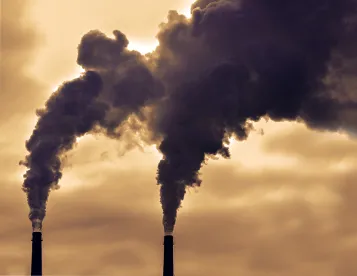Late last week, a bipartisan group of U.S. Senators introduced the Growing Climate Solutions Act, aimed at increasing and encouraging nature-based greenhouse gas (GHG) reductions in the agriculture and forestry sectors.
Key Takeaways:
-
The bill would direct the U.S. Department of Agriculture (USDA) to develop a suite of programs to support greenhouse gas (GHG) reductions and carbon sequestration through agriculture and forestry, by providing technical expertise and clearer access to markets.
-
While carbon offset programs for these sectors already exist, access to markets and upfront development costs can be high, especially for smaller landowners and agriculture businesses. Technical and informational limitations also create barriers to participation in existing programs.
-
This legislation is specifically targeted at three “roadblocks” holding back domestic farmers, ranchers, and private forest owners from participating in GHG markets: (1) uncertainty about how to implement projects or navigate carbon markets; (2) uncertainty regarding trustworthy players in carbon markets; and (3) a lack of agricultural or forestry expertise by existing carbonmarket participants.
-
Businesses, landowners, and other stakeholders who may be interested in adding revenue through carbon offset projects should monitor this bill and other related GHG developments.
Carbon Offset Bill Introduced with Broad Bipartisan Support
The Growing Climate Solutions Act continues the trend towards “nature-based” GHG reductions, which use an ecosystem approach to reduce GHG emissions and to encourage carbon sinks. This approach is accelerating in the United States and around the world as nations and private actors look to achieve GHG reduction targets under the Paris Agreement and mandatory reduction or offset programs and to advance private governance objectives. The bill’s goals also accord with state-level efforts in places like California and Washington, which in recent years have also created (or are considering) their own nature-based GHG reduction programs.
The lead sponsor of the Growing Climate Solutions Act is Sen. Mike Braun (R-Ind.), Chairman of the Senate Subcommittee on Clean Air and Nuclear Safety, within the Committee on Environment and Public Works. His Democratic counterpart on the subcommittee, Sen. Sheldon Whitehouse (D-R.I), also joined as an original cosponsor along with Sen. Lindsey Graham (R-S.C.) and Sen. Debbie Stabenow (D-Mich.), the top Democrat on the Senate Committee on Agriculture, Nutrition, and Forestry. The bill is endorsed by a remarkably broad array of supporters, including many large corporations and environmental groups, as well as several agricultural and forestry industry trade associations.
The Details
If enacted into law, the bill would amend the Food Security Act of 1985 to add a new section 1240M, “Greenhouse Gas Technical Assistance Provider and Third-Party Verifier Certification Program.” This new authority would require USDA to establish the titular Certification Program and would help to break down existing GHG market barriers in five important ways.
First, and most significantly, USDA would “publish a list and description of standards” from “widely used industry protocols” for GHG credit markets, such as sampling methodologies, accounting principles, systems for verification, monitoring, and reporting, and certain methods for additionality, permanence, and leakage. These USDA-sanctioned standards would be used to encourage sustainable, climate-friendly farming and forestry practices by connecting private-sector capital with farmers, ranchers, and private owners of forests. These standards would also be designed to assist those farmers, ranchers, and private forest landowners with voluntary participation in GHG credit markets.
Second, third-party consultants could apply to be “USDA certified” to provide technical expertise or verify compliance with those standards, as applied to land- and agriculture-based GHG credit projects. USDA would periodically audit these “certified” entities to ensure ongoing compliance with the standards.
Third, USDA would establish a website that the bill authors call a “one stop shop” for farmers, ranchers, and private forest owners seeking information and resources on how to participate in carbon markets.
Fourth, the bill would create a large “Advisory Council” to advise USDA concerning its administration of the program, comprised of at least two-dozen USDA-appointed members. The bill specifies a minimum (and in some cases, also a maximum) number of members representing the U.S. Environmental Protection Agency (EPA); the agriculture industry; the forestry and forest products industry; scientific researchers; experts in private GHG credit markets; relevant non-governmental organizations; and private interests who purchase GHG credits.
Fifth, the bill would require USDA to consult with EPA to develop an “Assessment of Greenhouse Gas Credit Marketplaces and Verification Regimes,” first due in October 2022, and with follow-on assessments produced every four years. These quadrennial assessments would analyze the status of the domestic and global markets for GHG credits; the state of monitoring technologies to quantify long-term carbon sequestration; ways to leverage other federal programs to support those monitoring technologies; and the potential for USDA to become more directly involved in reducing barriers to entry. The assessments would also be accompanied by reports to the House and Senate committees with general jurisdiction over agriculture. In addition to reporting the findings of each assessment, these reports to Congress may include recommendations regarding additional legal authorities that would help to reduce compliance and verification costs for farmers, ranchers, and private forest owners.
Prospects and Looking Forward
The Senate Parliamentarian will likely refer this legislation to the Senate Agriculture Committee, where original cosponsor Sen. Debbie Stabenow is the top Democrat. With Republicans in control of the Senate, however, it will likely be up to Committee Chairman Pat Roberts (R-Kan.) whether to hold a hearing on the legislation—much less a committee vote to advance the legislation or a floor vote to pass it. There is also not yet any companion legislation in the House of Representatives and, with only a few months remaining in the 116th Congress, enactment into law this year remains highly in doubt.
Regardless of the Growing Climate Solutions Act’s prospects in this Congress, the bill’s introduction signals bipartisan legislative recognition of the successful efforts recently made to reduce carbon footprints in forestry, farming, and ranching. Its introduction may also indicate increased congressional interest in climate-focused legislation going forward and, in particular, renewed focus on supporting—and rewarding—carbon sequestration in the forestry and agriculture sectors.







 />i
/>i
